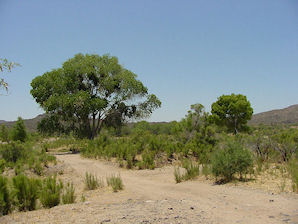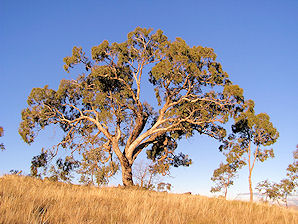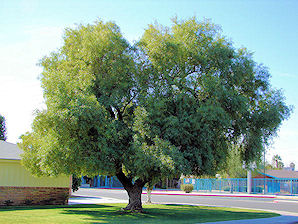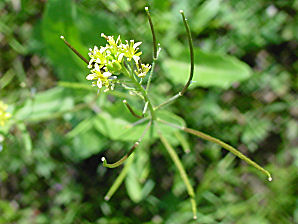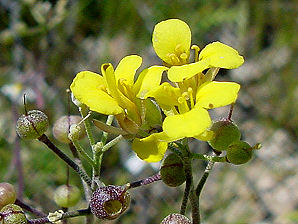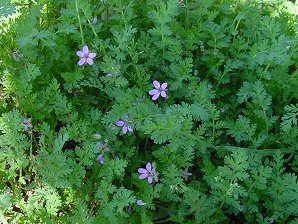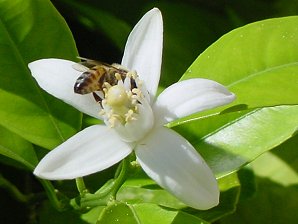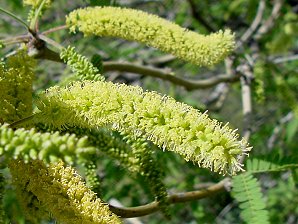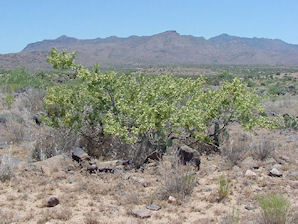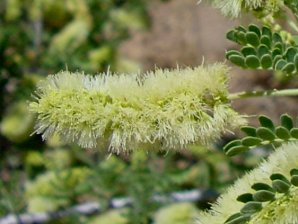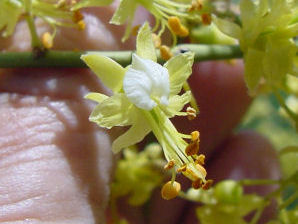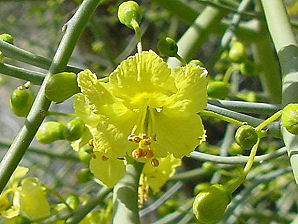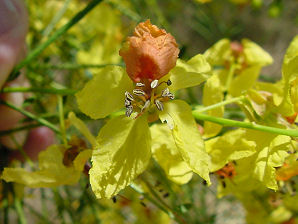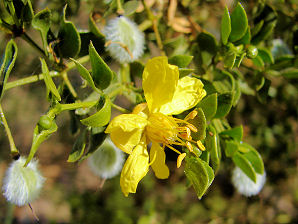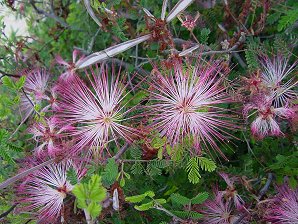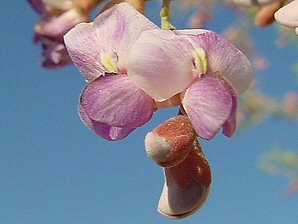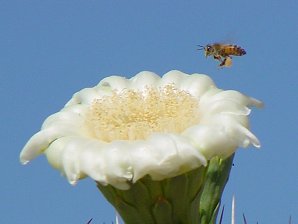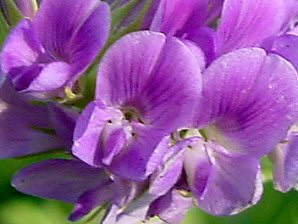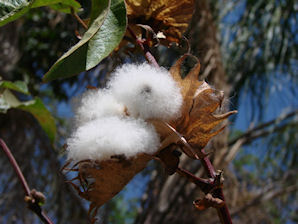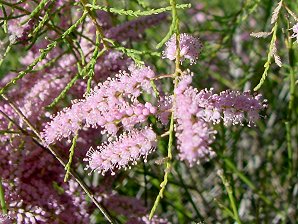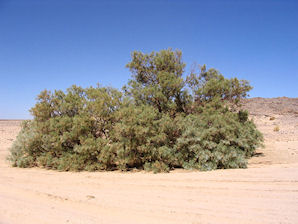Pictures, Photos, Images
Descriptions, & Reviews.
Managing The Honeyflow
For Honey Production In Arizona.
George & Eve DeLange
We Are Proud Of Our SafeSurf Rating!
Beekeeping In Arizona. We wish to thank Wikipedia, the free encyclopedia for some of the information on this page. We share images and information with Wikipedia. George DeLange, who has kept honeybees in Central Arizona for many years will offer some of his insight into keeping bees in the desert Southwest. George hopes this advice will prove helpful to others who wish to keep bees in either the Arizona Mountain Areas, Central Arizona, or the Low Elevation Regions, Near Yuma, which is officially at 138 feet elevation. However, George thinks this advice might also be helpful to anyone keeping honeybees in the Southwestern United States. Beekeeping in this area is much different from beekeeping in other areas. Some of the obvious challenges in Arizona & the southwest; not seen in other regions of the United States are:
a. Very extreme temperatures.
And then another factor in Arizona is that we have a great degree of diversity in our southwestern landscapes and their corresponding temperatures. These extremes vary; from low plains and valleys; with higher temperatures, to our very high, rough, mountain ranges; with their very low temperatures. Of course, that is good news since that means, in Arizona, we have a very diverse type of vegetation for our bees to forage. Here are a few examples of our extremes.
1. Temperature:
During the summer months, high temperatures are common throughout the lower elevations. Temperatures over 125� F have been observed in the desert areas. Great extremes occur between day and night temperatures throughout Arizona. The daily range between maximum and minimum temperatures sometimes runs as much as 50�F to 60�F during the drier portions of the year. This means that during the summer, the pine-clad forests in the central part of the state may have afternoon temperatures of 80�F - 96�F, while night time temperatures drop to 35�F or 40�F. That all means that the length of the growing season (period between freezes) varies tremendously over Arizona, averaging less than three months in some of the higher areas in the northern and eastern portions of the state. On the other hand, lower desert valleys sometimes have several years in succession without freezes.
2. Precipitation:
Considering elevation, our rainfall from 1961 to 1990; averaged about 8 inches in the Yuma flat & low area to as much as 20 to 36 inches near the Payson Area, at higher elevations, near the center of the state. From November through March, storm systems from the Pacific Ocean cross the state. These winter storms occur frequently in the higher mountains of the central and northern parts of the state and sometimes bring heavy snows. Snow accumulation may reach depths of 100 inches or more during the winter. The gradual melting of this snow during the spring serves to maintain a supply of water in the main rivers of the state. Reservoirs on these streams supply water to the desert areas in the lower Salt River Valley and the lower Gila River Valley areas, which are extensively farmed. Summer rainfall usually begins early in July and usually lasts until mid-September. Moisture-bearing winds sweep into Arizona from the southeast, with their source region in the Gulf of Mexico. Another important source of moisture for southern Arizona is the Gulf of California. Summer rains occur in the form of thunderstorms which result largely from excessive heating of the ground and the lifting of moisture-laden air along main mountain ranges. Thus, the heaviest thunderstorms are usually found in the mountainous regions of the central and southeastern portions of Arizona. These thunderstorms are often accompanied by strong winds and brief periods of blowing dust prior to the onset of rain. Hail also can occur rather infrequently. This summer rainfall in Arizona is now called Arizona�s Monsoon Season. When George was growing up in Arizona, it was simply called the Dust Storm Season. You might wonder, how can Arizona have a Monsoon? I thought that only happened in India! Well, we do! And it�s caused by basically the same reasons. Here�s something for you to know. Up until 2008 Arizona's monsoon varied from year to year in starting date and duration. It still does! The Arizona monsoon officially began after the third consecutive day of dew points above 55 degrees. On average this occurred around July 7 with the monsoon continuing for the next two months. Then in 2008 the National Weather Service decided to take the science out of the monsoon start and end dates. They arbitrarily said; that from now on; June 15 will be the first day of the monsoon, and September 30 will be the last day. They said that they did this, simply to take the focus of whether or not a storm was considered a monsoon storm or not out of the discussion, and to have the average person to be more concerned about their safety, during the monsoon season. My advice to you as a beekeeper would be to keep the arbitrary dates in mind, but remember the real way of knowing if there is a chance of a monsoon season storm. It is better defined as the third consecutive day of dew points above 55 degrees or above. That�s the real science! Here�s why you need to know. It�s about flooding! You don�t want your bee hives to be in a wash, during a flood! Flood conditions usually occur infrequently, although the heavy thunderstorms during monsoons in July and August, at times, have caused floods that do considerable local damage. Floods on the main rivers are mostly limited to the upper basins above the storage dams. While flooding in widely populated areas is rare, it usually happens in some populated area, just about every summer. For example, on July 4, 2012, Arizona City, which is located near Casa Grande, in Pinal County was flooded by a minor monsoon storm, which damaged dozens of homes. Our heaviest runoff usually occurs in connection with the arrival of moist tropical air which has its origin in hurricanes that dissipated as they reached land, outside of Arizona. Yes, we get �some� heavy rains associated with these systems during August or September, near the end of our monsoon season, but �extreme� heavy rains are likely to occur on the average of once every ten years, in Arizona. Then, we often get high winds accompanying these heavy thunderstorms sometimes reaching peak gusts of about 100 miles per hour in some local areas, while tornadoes are reported on the average of about once a year. All of these conditions are why you need to have your bee hives located in areas that are on higher ground and sheltered from the high winds of our summer storm season. And be aware that while you must shade your bees in the summer, these strong winds often break tree branches and can knock down trees, onto your bee hives. So, its� a good idea to check upon your hives, after a storm. In one respect, we are lucky that these monsoon storms occur in the summer, so we can plan for them! So, since our rainfall basically occurs twice a year. With the slower rains during the winter time, and the fast and furious thunderstorms, during the summer monsoon season. This has a very profound influence upon our flower blooming seasons; which leads us to our third challenge in Arizona Beekeeping, sparse bee forage! Here�s how that works! Rainfall is important to beekeepers since, rainfall has a very profound influence upon our flower blooming seasons. Our summer rainfall and winter rainfall determine our flower blooming in the spring. Our summer rainfall also determines our fall blooming season. Lots of summer rain and winter rain, then good flower bloom for the spring! Lots of summer rain, then good flower bloom in the fall! No rain, well then, not so good bloom! All of this discussion makes it very difficult to make general statements about Arizona & Southwestern beekeeping techniques. But I will try! Back when George started beekeeping about 40 or 50 years ago, honey bees were usually kept in permanent bee yards year-round, using only the standard Langstroth deep supers with either two or three supers on each colony. The frames were removed and the honey was extracted, whenever it was available. A few beekeepers had mobile extracting plants to remove honey. Many had just started to have their own permanent buildings for honey extraction. Nowadays, beekeepers have started to use shallow supers for producing honey, and they are taking these into permanent buildings for extraction. (It�s easier to do). The use of the shallow supers makes it easier to get a super full of honey (in case there is a shortage of nectar to extract), and it is easier to move the supers due to their lighter weight. Special Note: Just like most commercial beekeepers throughout the United States, many Arizona beekeepers now also move their colonies to southern California for the almond pollination. But, this involves owning many bee hives as well as a lot of equipment. It is not something that hobby beekeepers usually do.
Plants That Produce Honey: As, Al Weichold, the old beekeeper, who taught George, said; �to get honey, you must follow the honeyflow.� Al meant by honeyflow, to �follow the flowers, producing nectar! Pollen is also nice to get!� To follow the honeyflow, in Arizona and the Southwest in general; Arizona beekeepers locate their apiaries in irrigated agricultural areas, and they often move them from place to place, to take advantage of the different cultivated crops. They also move them from place to place, to take advantage of the natural vegetation growing at our varying elevations. Now, if we are going to move our bees, to follow the honeyflow, here is something we must be very concerned about. And, while these two rules apply to hives we are not moving, they especially apply, if we are moving our hives, from one temporary location to another. We Must Locate Our Bees So That They Have Both Water, And Shade. Remember, summer temperatures can often exceed 110�F (43.3�C) in the shade at lower elevations, and at these temperatures, bees spend a lot of energy carrying water back to their colonies to air condition their broodnest. Therefore, beekeepers must either supply water to the bees or locate their apiaries near cattle watering tanks, irrigation ditches, or other places that have a continuous source of water, within a � mile flight range. Then, when it comes to shade, the bees must have it too! Some beekeepers will actually build shade structures called "ramadas." These are frameworks covered with shade cloth or brush. Some, �backyard beekeepers,� actually build very attractive ramadas in their back yards for their bees. Since we are now backyard beekeepers, we keep our bees in a shady spot under some huge oak trees. In addition, other large trees such as mesquite, tamarix, and cottonwood provide excellent shade. Not only is this good for the bees, it is also good for the beekeepers! So, here Is A General Discussion About The �Honeyflow,� In Arizona. The author of this article, George DeLange taught High School Life Science and Environmental Science from 1983 until 2003 in the Phoenix Area. Part of his class that he taught was the "Merriam Life Zones Of Arizona" in which the living organisms in the areas are determined by the factors of temperature and available water which are also influenced by the various elevations found within the State Of Arizona. In this discussion, I will also present some of this little known information about the "Merriam Life Zones Of Arizona" so that you might use that information, in following the honeyflow in Arizona. In this discussion, I will try to describe the location of the plant as well as the name and description of the plant. I will also try to list the plants in order according to their blooming times and the availability of either nectar or pollen. Overwintering Your Hives.
Eucalyptus Trees ( Eucalyptus species ).
If you overwinter your colonies in riparian areas; your bees are likely to get their first pollen from Cottonwood Trees ( Populus fremontii ). You could get some Eucalyptus Tree (Eucalyptus species.) bloom.
January & February.
Eucalyptus Trees ( Eucalyptus species ).
In January and February, African Sumac (Rhus lancia), as well as Eucalyptus Tree (Eucalyptus species.) which are planted as urban trees, are blooming.
Also In January & February.
Bladderpod Mustard ( Lesquerella gordoni ).
In January and February, annuals, such as London rocket (Sisymbrium irio), & Bladderpod Mustard (Lesquerella gordoni), also are blooming at this time.
Also In January & February.
Filaree ( Erodium cicutarium ).
In January and February, annuals, such as Filaree (Erodium cicutarium.) also are blooming.
March.
March is when the citrus start to bloom, and some of our lower elevation areas produce great honey crops from this. In the Phoenix Area the average date for the start of the Citrus is March 15th. But, that date can vary a bit, due to the weather! It usually starts a few days earlier on the south side of phoenix than it does on the north side. When you consider the citrus, different types of citrus bloom earlier than others. Usually, grapefruit, then lemons, then oranges. Even some varieties of the same fruit bloom earlier than others. So it matters which citrus your bees are on. With this being said, due to urban development, we are losing more and more of our citrus to development. Sometimes during the end of the citrus bloom or shortly after the citrus bloom, the desert mesquite honeyflow starts. In the Phoenix Area it usually starts about April 15th. Some beekeepers extract the orange honey off before it can be mixed in with the mesquite nectar.
April.
Sometimes during the end of the citrus bloom or shortly after the citrus bloom, the desert mesquite honeyflow starts. In the Phoenix Area it usually starts about April 15th. The main desert honey, is from Velvet Mesquite ( Prosopis velutina ). The next desert honey, will come from Catclaw Acacia (Acacia greggii). Some beekeepers will extract the mesquite honey off before it can be mixed in with the catclaw nectar.
Also In April.
While the main desert honey, is from Velvet Mesquite ( Prosopis velutina ), the next is from Catclaw Acacia (Acacia greggii). Catclaw Acacia also blooms during April into June, depending upon rainfall amounts. The catclaw acacia usually starts blooming in late April and stops in mid to late May. In higher elevations it usually stops blooming in early July.
Also In April - July.
Blue Palo Verde (Parkinsonia floridum). Mexican Palo Verde (Parkinsonia aculeata).
There are other plants blooming at various times during April through July at these lower elevations that also provide nectar and pollen. Their nectar and pollen often can become mixed into the other nectar and pollen that the bees are storing in their hives at these times. Some beekeepers extract the mesquite or catclaw honey off, before it can be mixed with these other nectars. Some of these more common plants include the three main types of palo verde; Foothill Palo Verde (Parkinsonia microphylla), Blue Palo Verde (Parkinsonia floridum), & Mexican Palo Verde (Parkinsonia aculeata).
Also In April.
Fairy Duster (Calliandra eriophylla).
Two other good bee plants that are blooming now are also, Creosote Bush (Larrea tridentata), & Fairy Duster (Calliandra eriophylla).
Also In April.
Saguaro Cactus {Carnegiea gigantea).
Then there is the Ironwood Tree (Olneya tesota), and of course the iconic Saguaro Cactus {Carnegiea gigantea).
Some higher elevation plants that are good for bees at this time of the year include burroweed (Haplopappus spp.), and at elevations of 4,000 to 5,000 feet, sandpaper plant (Mortonia scabrella) will also be blooming, as will some of the agaves. "Sugar-bush," which is a local name for buckbrush (Symphoricarpos oreophilus), which is found at elevations over 5,000 feet north of Phoenix.
Now, here is the time where the "Merriam Life Zones Of Arizona" In 1889 C. Hart Merriam studied the distribution patterns of plants and animals in a broad swathe from the lower elevations of the Grand Canyon to the top of Humphreys Peak (elevation 12, 760 feet) in the San Francisco Mountains near Flagstaff, Arizona. Based on his observations in the field, Merriam developed the concept of a Life Zone, a belt of vegetation and animal life that is similarly expressed with increases in altitude and increases in latitude. These Life Zones (sometimes called "Vegetative Communities") are unique groupings of plants and animals based on elevation. These communities take into account the fact that for every 1,000 feet gain in elevation the temperature drops 3 degrees F and the precipitation increases as well. The plants and animals you'll likely encounter in the life zone depends upon the varying elevations as you climb up a mountain or "sky island" in Arizona such as the Santa Catalina Mountains. Keep in mind that what you will see when you visit each vegetative community is dependent on the season of the year and the amount of precipitation for that year. Over the years Merriam's Life Zones have been changed and modified as new information has been researched and revealed. But, they are basically the same as when Merriam did his original work on the subject. Ok, so how does that information help you to follow the honeyflow? Or better yet, to get a longer honeyflow! After all, don�t you want more honey? Well, here is how it works for you and, for me too! It�s Simple! Just take your bees up into the mountain areas a few hundred feet of elevation at a time and the same plant that you were getting nectar from, will probably still be blooming at the higher elevation! Of course, you should scout out the areas ahead of time and have gotten the permissions from the land owners, before you move your bees! For example, catclaw acacia (Acacia greggii), quit blooming this year (2012) in the Lake Pleasant, Arizona Area in Mid � June. But, it had just started to bloom in Kirkland when it had finished blooming in the lower elevation of the Lake Pleasant Area. At the time of writing this article, the Acacia has just stopped blooming for this year in Kirkland, Arizona, on July 9, 2012. So by moving my bees up in elevation, I would have caught a new blooming time for the Acacia, and I would have gotten about 2 � 3 weeks more nectar production for my bees! This strategy will work for most honey producing plants! Now back to our discussion about the yearly honeyflow. Recall, that a good desert honeyflow will depend on the winter rainfalls, which could extend or shorten the blooming times. If we have had a good winter rainfall and then are blessed with a good spring or early summer rainfall, Mesquite can bloom a second time. This could result in another small honeyflow. But, if strong winds or unseasonal rains occur during its bloom, there will be little or no nectar. Many beekeepers in Arizona use the time after the normal spring mesquite bloom for a time to do maintenance or extracting. This is also a very good time to collect more nectar for honey production. Since all beekeepers are good at multitasking, they not only do maintenance & extracting, but they move their hives to either alfalfa or cotton fields, where they can get another honey crop. However, this is becoming more difficult to do every year. That is due to farm land being converted into developed land and due to the fact that some areas that were used for cotton have switched to other crops or are using genetically modified cotton, which some beekeepers claim that the bees do not like as much as the older unmodified cotton.
In May through October.
Cotton (Genus - Gossypium), Variety, AG3601.
At this time of year there is the Alfalfa, (Medicago sativa), and Cotton (Genus - Gossypium), Variety, AG3601. I personally have moved my bees to the Alfalfa fields and my bees have produced large amounts of honey from Alfalfa. The only downside of this was that the farmer usually mowed his fields before the plants could fully bloom. Thus, the production was not as high as it could have been. I have tried cotton, but it was not productive. Special Note! This special note can save you time and money! If you can do this, it will save you from making the next two normal seasonal moves! I will discuss the next two seasonal moves after this special note. It is possible to find a place to keep your bees that will provide all that they need from this point in the year, until time to start the annual honeyflow, all over again. This will save you the time and expense of moving your bees and your bees will be less stressed. Well here it is! Find a place where they are shaded by Tamarisk and/or Eucalyptus Trees. And make sure your bees are also located near to Alfalfa fields. Of course, they need to be near water. If you do that, you won't have to move them, until time to move them to the citrus groves. Oh, it's also possible to already be on a citrus grove, if you do some looking around. I found one! But, I'm not telling!
In Late Summer Close To Winter. Getting Close To Time To Overwinter!
Athel Tamarisk (Tamarisk aphylla).
By now we are into the late summer and fall. Good places to have you hives would be in desert areas having a heavy, brush growth of salt cedar (Tamarix pentandra), or the related wild tree known as Athel (Tamarix aphylla), may bloom again and will provide bee forage throughout the summer if moisture is adequate. Remember, to keep the bees near to water & in the shade! When it is time to overwinter your bees, they need good stores of honey, just like colonies do in the northern regions of the United States.
Late Summer Through Winter. Time To Overwinter!
Cotton (Genus - Gossypium), Variety, AG3601.
At this time of year I try to keep my bees very near to town, and close to an alfalfa field. I also try to do this where my colonies would be near large numbers of Eucalyptus Trees (Eucalyptus species.), and other ornamentals. I do this because, they often provide sufficient pollen and nectar throughout the winter months, to support continued brood rearing. Questions I Often Hear. I am often asked if bees get much from cactus. While I have seen bees on various cactus, bees do not normally pollinate cactus, such as prickly pear (Opuntia spp.). I am also asked what local Arizona crops bees should be moved to for pollination. The most commonly grown crops include melons and other cucurbits, alfalfa, onion, and carrot (grown for seed).
Other Challenges Of Arizona Or Southwest Desert Beekeeping: Other challenges Of Arizona or Southwest Desert beekeeping include hazards such as rattlesnakes, scorpions, & poison�ous spiders that nest under the outer covers, or bottom boards. Then there are the fire ants that love to invade bee colonies, not to mention the numerous plants covered with spines and thorns, that cover our deserts and yes, even in our mountains. In addition, most of the feral bee colonies, especially in our lower elevations, are now Africanized, and beekeepers have had to learn how to manage these bees. Several have done so successfully, however, and good honey and pollen crops have been ob�tained in these areas. Most of the same pests and diseases common to bees elsewhere, also occur in the Southwest, such as wax moth, which can be a year-round problem, as well as both of the two foulbroods, as well as chalkbrood. Tracheal Mites are still a problem, and Varroa Mites are causing problems as well. One good thing to say about the dreaded African honeybee is that they swarm frequently, and abscond from their nest, thus, solving the Varroa Mites problem in their hive!
|
Here Are Some Links To The Very Best & Most Popular Items Sold On Amazon.Com
To Learn More! Click The Links Below. No Obligation, Of Course!

